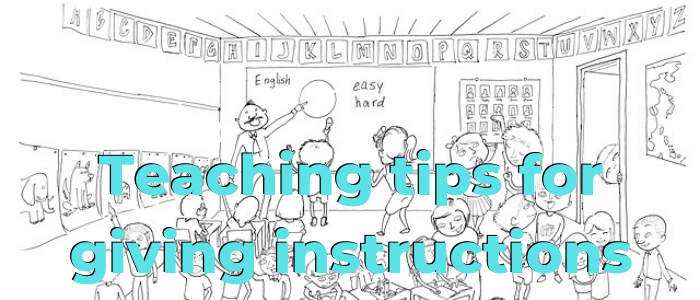Before you start giving your instructions, make sure you have everyone’s attention. Wait until all the students stop talking, are seated, calm, and ready to listen to.
Instructions must be kept as simple as possible and they must be logical.
For example:
- Now, I want you to get out a piece of paper and put it on your desk. Once the paper is on your desk, could you please write down five sentences about what you did last weekend? (Wordy commands)
- Please, take a piece of paper, and then write down five sentences about what you did last weekend. (Concise commands)
Try not to give students too much information at once. Especially for kids who have attention challenges, try to avoid giving a series of instructions. Instead, create a step by step outline.
Make sure that you can explain students within the limits of the language which the students can understand. Giving instructions filled with idioms and not common phrases to a group of lower-level learners will destroy their confidence. Instead, speak slowly and clearly with short sentences that convey exactly what you want them to do.
- Get into pairs – You two, you two and you two.
- Pick out - Choose
- Let’s go over the answers – Now, check the answers
- Fill in – Complete
- Come up a poem – Invent a poem
With lower-level learners, you may need to demonstrate what you want them to do, along with verbal instructions. Use the whiteboard to illustrate the meaning of such words as choose, underline, and match.
Incorporating nonverbal communication and gestures is an effective way to maximize time for teaching and learning. Sign language can enhance the learning process by bringing visual, auditory and kinesthetic feedback to help reach all students.
The tone of voice can change everything, especially when telling someone what to do. Speak at a reasonable volume and use kind respectful words.
Try to avoid imperative such as “listen to me” or “stand up”, we don’t use them in “real life”. Instead, be polite and use request forms such as “Could you please stand up?” and “Can you please listen to me?”.
Before you start an activity, let students know how much time they will have. This helps students stay focused on the task and manage their time.
Get your students truly engaged by giving them opportunities to ask questions about the activity. The better they understand what to do, the greater chance for a successful outcome.
Always check that students have understood your instructions before starting the activity. The question “Do you understand?” is as good as useless. Students may be too shy to admit that they don’t understand or may think they understand when they don’t.
- “How many sentences do you need to write?
- “How much time do you have to complete the activity?”
- “Who is the winner?”
- “If you are “A”, what are you going to do?”
- “What three rules do you need to remember?
If you find that all or most students are off track, stop the activity and give instructions to the whole class again. If only a few students need help, you can assist them individually or in their groups while the rest of the class continues with the activity.
After the class, reflect on your instructions.










